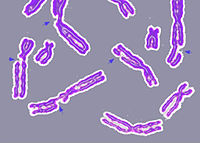
Photo from wikipedia
Replication protein A (RPA) is a ubiquitous ssDNA-binding protein that functions in many DNA processing pathways to maintain genome integrity. Recent studies suggest that RPA forms a highly dynamic complex… Click to show full abstract
Replication protein A (RPA) is a ubiquitous ssDNA-binding protein that functions in many DNA processing pathways to maintain genome integrity. Recent studies suggest that RPA forms a highly dynamic complex with ssDNA that can engage with DNA in many modes that are orchestrated by the differential engagement of the four DNA-binding domains (DBDs) in RPA. To understand how these modes influence RPA interaction with biologically relevant ligands, we performed a comprehensive and systematic evaluation of RPA's binding to a diverse set of ssDNA ligands that varied in sequence, length, and structure. These equilibrium binding data show that WT RPA binds structured ssDNA ligands differently from its engagement with minimal ssDNAs. Next, we investigated each DBD's contributions to RPA's binding modes through mutation of conserved, functionally important aromatic residues. Mutations in DBD-A and -B have a much larger effect on binding when ssDNA is embedded into DNA secondary structures compared to their association with unstructured minimal ssDNA. As our data support a complex interplay of binding modes, it is critical to define the trimer core DBDs' role in binding these biologically relevant ligands. We found that DBD-C is important for engaging DNA with diverse binding modes, including, unexpectedly, at short ssDNAs. Thus, RPA uses its constituent DBDs to bind biologically diverse ligands in unanticipated ways. These findings lead to a better understanding of how RPA carries out its functions at diverse locations of the genome and suggest a mechanism through which dynamic recognition can impact differential downstream outcomes.
Journal Title: Biochemistry
Year Published: 2022
Link to full text (if available)
Share on Social Media: Sign Up to like & get
recommendations!